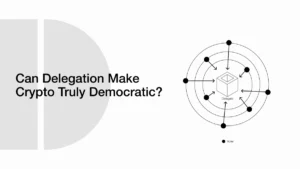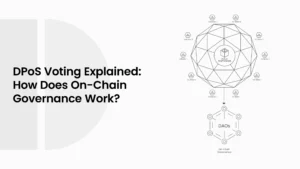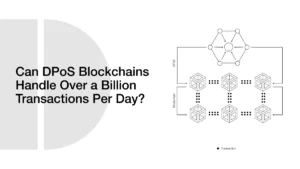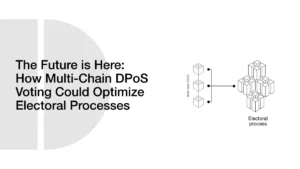DPoS in 6G Networks: The Future of Blockchain and Hyperconnected Economies
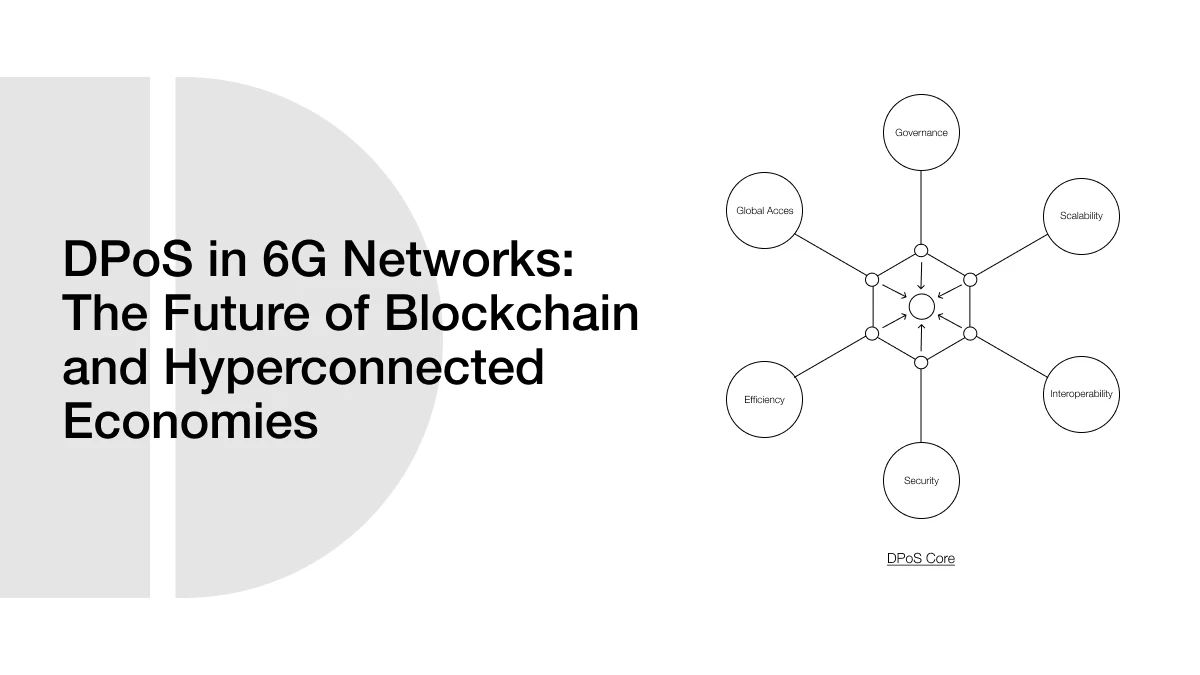
Every new generation of wireless networks has changed the way people live. The first generation gave us simple mobile calls. The second added text messages. The third gave us the mobile internet, and the fourth made streaming and apps a way of life. 5G allowed the world to enter the era of quick connections, which could be used to support the new tools such as cloud gaming, remote surgeries, and smart factories.
- What is 6G?
- Comparison Between 5G and 6G
- Basics of Blockchain and DPoS
- What is Blockchain?
- What is Delegated Proof of Stake (DPoS)?
- Why DPoS Fits 6G
- Consensus Mechanisms Compared
- Why DPoS is Important in 6G Networks
- Handling Millions of Devices
- Ultra-Low Latency Requirements
- Building Trust in Hyperconnected Economies
- Use Cases of DPoS in 6G
- Smart Cities and IoT
- Autonomous Vehicles
- Healthcare and Remote Surgeries
- DPoS Use Cases in 6G
- Challenges of Using DPoS in 6G
- Scalability vs Security
- Delegate Centralization Risks
- Energy and Infrastructure Costs
- Benefits of DPoS-Enabled 6G for Hyperconnected Economies
- Faster Cross-Border Transactions
- Transparency in Supply Chains
- Secure Digital Identity
- Foundation for Web 3.0 and Metaverse Services
- Economic Benefits of DPoS + 6G
- Research, Projects, and Standardization
- The Role of Standardization
- Why DPoS Needs to Be Part of the Standards
- Conclusion
- Frequently Asked Questions for DPoS in 6G Networks
- What is 6G, and how is it different from 5G?
- What is Delegated Proof of Stake (DPoS)?
- Why is DPoS important for 6G networks?
- What are some real-world uses of DPoS in 6G?
- What challenges does DPoS face in 6G?
- Glossary of Key Terms
But even with all these changes, the needs of our digital world are growing too fast. Billions of devices are coming online. From smart homes to driverless cars, the number of connected devices is reaching a level that 5G alone cannot handle. This is where 6G networks come into the picture. Experts say 6G will deliver speeds up to one terabit per second, sub-millisecond latency, and the ability to connect tens of millions of devices in a single square kilometer (Chowdhury et al., 2023). These features make 6G the backbone for what many call the hyperconnected economy, a future where almost every device, machine, and service is linked.
There is a large variety of blockchain models, but the blockchain model that fits 6G well is Delegated Proof of Stake (DPoS). DPoS avoids the energy waste of Proof of Work or the slowness of Proof of Stake by basing its selection of a few delegates to validate transactions on a voting system. This also makes it energy efficient, faster, and scalable, all of which are desirable attributes to 6G.
This blog explores how DPoS can play a role in making 6G networks secure and reliable, and why it may become the key to running hyperconnected economies. From smart cities to global finance, DPoS could be the bridge that makes 6G not only faster but also more trustworthy.
What is 6G?
6G is the sixth generation of wireless networks, and it is expected to be the most powerful communication system ever built. When 5G brought us smart factories, cloud gaming, and remote healthcare, 6G is going to take that even a step further. It will interlink billions of objects, such as sensors in our homes and machines in whole cities, in real time.
The largest change between 6G and previous generations is speed, latency, and density. Whereas 5G will have the capacity to support millions of devices in a square kilometer, 6G will target tens of millions. It will also make the lag in communication very low, even less than a millisecond, which is nearly instant. This will be crucial in their essential applications, such as autonomous vehicles, virtual reality surgeries, or even holographic meetings in real-time.
Another important element of 6G is its association with the Internet of Everything (IoE). Instead of linking phones or laptops, 6G will have the capacity to connect cars, robots, drones, appliances, sensors, and even wearable medical devices. This means that the network will not only be capable of transporting data, but it will also regulate and manage daily life to a degree that past systems could not.
Scientists believe that 6G will also be closely integrated with artificial intelligence (AI). As opposed to 5G, where AI is a minor component, 6G will be created with AI being a central feature. This enables quicker learning, superior automation, and intelligent decision-making at the network (Kato et al., 2020).
Because of these features, 6G is often described as the foundation of hyperconnected economies. It is not just about faster downloads. It is about building a system where industries, governments, and people can rely on seamless, trustworthy connections.
Comparison Between 5G and 6G
| Feature | 5G | 6G |
| Speed | Up to 10 Gbps | Up to 1 Tbps |
| Latency | ~1 ms | ~0.1 ms |
| Device Density | 1M devices per km² | 10M devices per km² |
| AI Integration | Limited support | Built into the core system |
| Main Use Cases | Cloud gaming, IoT, and remote surgery | Internet of Everything, holograms, smart cities, autonomous vehicles |
As you can see, 6G is not just an upgrade. It is a complete shift in how communication networks will operate. But with this shift also comes new risks: if so many devices are connected, then security, trust, and efficiency become critical. This is where blockchain, and more specifically, DPoS, comes into play.
ALSO READ: How Edge AI Optimizes Delegate Performance in Real-Time for Faster DPoS Blockchain
Basics of Blockchain and DPoS
What is Blockchain?
Blockchain is a digital ledger that is shared among multiple computers. Each new block of data, or block, is connected to the previous one as each new block is added. This forms a series of records, and this is why it is referred to as blockchain.
The unique aspect of blockchain is that no one is in charge of it. Rather, the data can be viewed and verified by all in the network. This renders it clear, safe, and reliable. What is written on the blockchain cannot be changed or deleted.
Simply put, blockchain eliminates a third party. Blockchain allows individuals or machines to trust the system rather than a bank or a firm that controls the information.
What is Delegated Proof of Stake (DPoS)?
DPoS is a way for a blockchain to agree on what data is valid. This process is called “consensus.”
In Bitcoin, consensus is reached with Proof of Work (PoW), where miners solve hard puzzles. But this wastes a lot of electricity and takes time. Proof of Stake (PoS) is faster, but it slows down with an increasing number of participants.
On the other hand, DPoS works differently. In this system, the users cast their votes to a small delegation of people whom they trust. Checking transactions and adding them to the blockchain is the work of these delegates. As few are selected, it is far quicker and less energy-consuming.
This renders DPoS to be an appropriate selection in systems requiring speed, low price, and scalability, such as 6G networks. With millions of devices talking at once, a consensus method that can keep up is necessary (Huang et al., 2021).
Why DPoS Fits 6G
- DPoS can handle many transactions per second without slowing down.
- It uses much less energy compared to Proof of Work.
- It is more scalable, which means it can grow as millions of new devices join.
- It is flexible enough to be combined with AI and edge computing in 6G systems.
Consensus Mechanisms Compared
| Mechanism | Speed | Energy Use | Decentralization | Best For |
| Proof of Work (PoW) | Low | Very High | High | Bitcoin and large public chains |
| Proof of Stake (PoS) | Medium | Medium | Medium | Ethereum 2.0 and staking systems |
| Delegated Proof of Stake (DPoS) | High | Low | Medium | 6G, IoT, real-time networks |
DPoS provides 6G networks with the balance they require: enabling fast real-time decision-making, efficient management of billions of devices, and secure building of trust. That is why numerous scholars are sure that DPoS may be the main consensus of the economy powered by 6G.
Why DPoS is Important in 6G Networks
Handling Millions of Devices
One of 6G’s biggest promises is the ability to connect millions of devices per square kilometer. Think of smart homes, autonomous cars, drones, hospitals, factories, and sensors that speak simultaneously. Conventional systems cannot cope with this traffic without experiencing slowdown.
DPoS comes in at this point. The system can process data much faster compared to the older blockchain techniques because a few elected delegates validate transactions. DPoS reduces the time of action confirmation, and this aspect implies that more devices can be connected without any delay.
Scalability is not a value-addition in hyperconnected economies where time is everything. In the absence of a system such as DPoS, the 6G would experience bottlenecks that would prevent industries from trusting it.
Ultra-Low Latency Requirements
Latency is the delay between sending and receiving information. For most people, a small delay in streaming a video is not a big deal. In 6G, however, latency is of paramount importance where remote operations, self-driving cars, or real-time holograms rely on immediate information.
DPoS is suitable to address these needs since it is a fast-consensus design. Transactions can be validated in seconds (or even less), unlike Proof of Work, which takes minutes. This matches the sub-millisecond latency goals of 6G networks.
Without a fast consensus system like DPoS, even the most advanced 6G infrastructure could fall short in areas like healthcare or transportation, where delays can be life-threatening.
ALSO READ: Can Hybrid Consensus Models Outperform Pure DPoS: A Real-Life Study
Building Trust in Hyperconnected Economies
In hyperconnected economies, billions of devices and businesses will interact without always knowing or trusting each other. As an example, a supply chain may include factories, freight operators, customs, and retailers in various countries. It is difficult to trust so many players.
Blockchain is already transparent and immutable; however, DPoS extends its transparency to a secure, yet efficient method of data validation. No single authority is in power since the network elects the delegates. This reduces the risk of corruption, manipulation, or single points of failure.
In short, DPoS helps build the trust layer for 6G economies. It ensures that data, transactions, and services remain secure and verifiable without slowing down the network. This makes it a strong candidate for powering the global digital economy of the future.
Use Cases of DPoS in 6G
Smart Cities and IoT
6G is often called the backbone of smart cities. In these cities, everything from traffic lights to power grids to waste systems will be connected to the network. Each second, millions of IoT devices will transfer data.
DPoS can be useful in this case by ensuring that data is validated within a short period of time and in a safe manner. To give an example, when a traffic signal should change according to the real-time situation of congestion, it should do it within seconds. In case it is too long, accidents and delays can occur.
By using DPoS, city services can trust the data flow without waiting for slow approvals. It ensures that smart cities run smoothly while also keeping records safe and tamper-proof.
Autonomous Vehicles
Driverless cars are one of the most demanding use cases for 6G. These vehicles need to communicate instantly with each other and with infrastructure like roads and sensors. A delay of even a fraction of a second could lead to accidents.
DPoS makes this possible, which provides fast and reliable consensus. The vehicles are able to update, validate updates via delegates, and respond. As an example, when a car brakes, vehicles around it must be immediately aware. The information is disseminated much quicker and more safely with the assistance of DPoS in the validation of these updates.
This makes DPoS a powerful tool for creating trust between machines on the road, where human reaction times are too slow.
Healthcare and Remote Surgeries
Healthcare is another area where 6G and DPoS can change lives. Doctors may perform remote surgeries using robots connected through 6G networks. For this to work, the data must be accurate, private, and delivered with almost no delay.
DPoS can validate medical data transfers, as well as ensure that every action is correct. In contrast to centralized systems, which can be hacked or overloaded, DPoS distributes trust among several delegates. This minimizes the possibility of one failure, which might endanger lives.
It also renders healthcare records more secure because they can not be altered or forged after they have been registered. This gives patients and hospitals more confidence in sharing and using sensitive information.
DPoS Use Cases in 6G
| Industry | 6G Need | Role of DPoS |
| Smart Cities | Billions of IoT devices need fast updates | Provides secure and real-time validation of data |
| Autonomous Vehicles | Instant communication between cars and roads | Enables ultra-low latency consensus for safe driving |
| Healthcare | Remote surgeries and patient data security | Protects privacy and ensures accurate, fast transactions |
| Finance | Global payments across networks | Supports fast, trusted cross-border settlements |
DPoS is more than just a technical option. It is a practical solution for industries that depend on real-time trust. From running a smart traffic system to protecting patient lives, DPoS gives 6G the speed and security it needs to unlock these future applications.
Challenges of Using DPoS in 6G
Scalability vs Security
6G promises to connect tens of millions of devices per square kilometer. While DPoS is faster than other consensus systems, the sheer scale of 6G could still push it to its limits.
The challenge is that speed and security often compete with each other. If you add more delegates to improve decentralization, the network may slow down. But if you keep fewer delegates for speed, the system could be more vulnerable to attacks.
Finding the right balance will be one of the hardest parts of using DPoS in 6G networks. Researchers are already exploring ways to combine DPoS with AI-based monitoring to keep both speed and safety intact.
Delegate Centralization Risks
In DPoS, users vote for delegates who validate transactions. While this makes the system faster, it also brings the risk of centralization. If only a few delegates gain too much power, they could act unfairly or even work together to control the system.
This risk is especially important for 6G, where billions of devices will rely on a fair and open system. If a small group of delegates misuses their power, it could lead to bias, censorship, or security failures.
Possible solutions include rotating delegates, using reputation systems, or adding random selection methods. These approaches can reduce the chance of centralization and make DPoS more reliable for 6G’s global scale.
Energy and Infrastructure Costs
One of the strengths of DPoS is its low energy use compared to Proof of Work. But in a 6G environment, where billions of IoT devices are constantly online, even low-cost systems can add up.
Many of these devices, such as sensors or wearables, will have limited power and processing ability. Running blockchain processes, even lightweight ones, could strain them. If not designed carefully, this could cause higher costs for infrastructure and energy.
Researchers suggest that combining DPoS with edge computing and lightweight blockchain models could reduce this issue. By moving heavy processes closer to local edge servers instead of tiny devices, the system can stay efficient while keeping power demands low (Saad et al., 2020).
In short, DPoS brings many advantages to 6G, but it is not a perfect solution. To succeed, it must overcome problems with scalability, fairness, and resource demands. These challenges do not mean DPoS is unfit for 6G. Instead, they highlight the work needed to make it ready for the hyperconnected future.
ALSO READ: How DPoS Validator-as-a-Service Will Shape the Next Staking Trend in 2025 and Beyond
Benefits of DPoS-Enabled 6G for Hyperconnected Economies
The rise of 6G is not just about faster phones or smoother streaming. It is about creating the backbone for hyperconnected economies, where industries, cities, and global trade depend on secure and instant communication. When combined with DPoS, 6G becomes more than a network. It becomes an economic engine that builds trust and efficiency.
Faster Cross-Border Transactions
In a hyperconnected economy, businesses will trade and exchange value across borders in real time. Traditional systems are slow, costly, and depend on intermediaries like banks. With DPoS running on 6G, transactions can be confirmed instantly and securely, regardless of the parties’ locations.
This can make global trade more efficient, reduce costs, and open new opportunities for businesses in both developed and developing regions.
Transparency in Supply Chains
Modern supply chains often stretch across multiple countries. Tracking goods, payments, and data is complicated and can be affected by fraud or delays. With DPoS in 6G, every action can be logged in a blockchain ledger, visible to all stakeholders.
This transparency builds trust between partners. Companies can confirm that goods are authentic, shipments are on time, and payments are secure. The result is a supply chain that is faster, safer, and more reliable.
Secure Digital Identity
In a world where billions of people and devices are connected, digital identity is critical. Fake identities and data breaches are already big problems today, and they could grow worse in 6G networks.
DPoS can help by providing secure and decentralized identity management. Instead of relying on a single company or government, identities can be verified and managed on a blockchain. This makes systems safer for everything from online banking to healthcare.
Foundation for Web 3.0 and Metaverse Services
The future internet, often called Web 3.0, will depend on decentralized services, virtual economies, and immersive digital spaces. These will require fast, trustworthy, and scalable networks.
By combining 6G with DPoS, these new digital worlds can run smoothly and securely. Whether it is virtual reality education, global e-commerce, or metaverse events, the technology stack will need consensus systems that can keep up. DPoS provides that base.
Economic Benefits of DPoS + 6G
| Benefit | Example | Impact on Economy |
| Cross-Border Trade | Instant payments between companies | Boosts global commerce and reduces costs |
| Supply Chain Management | Real-time product tracking | Cuts fraud, increases trust in goods and services |
| Digital Identity | Secure ID for billions of devices | Protects users and supports online transactions |
| Web 3.0 & Metaverse | Decentralized apps and VR platforms | Creates new digital markets and industries |
Research, Projects, and Standardization
The development of 6G is still in its early stages, but research has already started around the world. Countries like the United States, China, South Korea, Japan, and members of the European Union are investing heavily in 6G research projects. These projects explore not only the technical side, like faster speeds and lower latency, but also the integration of blockchain and new consensus methods.
For example, the European Commission launched programs under its Horizon 2020 initiative to test advanced 6G concepts. South Korea and Japan have announced national plans to lead in 6G, with trials expected before 2030. The US has also funded early-stage research into 6G security and network resilience (Dogra et al., 2020).
Blockchain is being looked at as a key enabler of trust and security in 6G. Several projects are testing how consensus methods like DPoS can handle massive device-to-device communications, especially in areas like smart cities, autonomous vehicles, and industrial IoT.
The Role of Standardization
For any wireless technology to succeed globally, it must follow common standards. These standards define how networks are built, how devices connect, and how services are delivered. Without standards, devices from one country or company may not work with those from others.
In 5G, organizations like the International Telecommunication Union (ITU) and the Next Generation Mobile Networks Alliance (NGMN) played a big role in setting rules. For 6G, the same bodies, along with new global collaborations, are working on frameworks that include blockchain and decentralized models.
DPoS could become part of these standards. Because it offers speed and scalability, researchers believe it is one of the most practical consensus models for handling 6G’s demands. If adopted, it may form the global trust layer for hyperconnected economies.
Why DPoS Needs to Be Part of the Standards
If DPoS is left out of 6G planning, networks may face problems with trust, latency, and scalability. Traditional consensus methods are either too slow or too costly to run in such massive systems. Standardizing DPoS now would ensure that when 6G rolls out, it is ready for real-world applications like healthcare, transportation, and finance.
In short, the work being done today on research and standardization will decide whether 6G becomes a smooth, global system or a fragmented one. By including DPoS in this process, policymakers and engineers can create a system that is fast, fair, and secure from the start.
ALSO READ: Breaking Barriers: Why DPoS Could Be the Future of Borderless Credit and Microfinance
Conclusion
6G is expected to be the backbone of hyperconnected economies, where billions of devices, industries, and people communicate in real time. But speed and scale alone are not enough. Without trust, security, and fairness, the promise of 6G will remain incomplete. This is where Delegated Proof of Stake (DPoS) becomes a powerful solution. By offering fast consensus, low energy use, and reliable validation, DPoS matches perfectly with the demands of 6G networks.
Looking ahead to 2030 and beyond, DPoS could play a central role in making 6G not just faster, but also more dependable for critical industries like healthcare, finance, smart cities, and autonomous transport. If adopted as part of global standards, DPoS may become the trust layer of the digital economy, ensuring that future societies run on systems that are secure, transparent, and efficient.
Frequently Asked Questions for DPoS in 6G Networks
-
What is 6G, and how is it different from 5G?
6G is the next generation of wireless communication expected to deliver speeds up to 1 Tbps, sub-millisecond latency, and the ability to connect tens of millions of devices per square kilometer. Unlike 5G, it integrates AI into the core and supports the Internet of Everything.
-
What is Delegated Proof of Stake (DPoS)?
DPoS is a blockchain consensus mechanism where users vote for a small group of delegates who validate transactions. It is faster and more energy efficient than Proof of Work or Proof of Stake, making it ideal for large-scale systems like 6G.
-
Why is DPoS important for 6G networks?
6G will need fast, secure, and scalable systems to support billions of devices. DPoS helps by offering ultra-fast consensus, lower energy use, and reliable validation, which makes 6G more trustworthy.
-
What are some real-world uses of DPoS in 6G?
Use cases include smart city management, autonomous vehicles, remote healthcare surgeries, and global trade systems. DPoS ensures these services are secure, fast, and reliable.
-
What challenges does DPoS face in 6G?
Key challenges include balancing scalability with security, preventing delegate centralization, and reducing resource demands for billions of devices.
Glossary of Key Terms
- 6G – Sixth generation of wireless networks designed for ultra-fast, low-latency, high-density connections.
- DPoS (Delegated Proof of Stake) – A blockchain consensus model where elected delegates validate transactions.
- Consensus Mechanism – The process by which blockchain networks agree on valid transactions.
- Latency – The time delay between sending and receiving data.
- IoE (Internet of Everything) – The connection of devices, machines, people, and systems into a global digital network.
- Smart City – A city that uses connected devices and data to improve efficiency, safety, and sustainability.
- Hyperconnected Economy – An economy where all devices, industries, and services are interconnected digitally.

